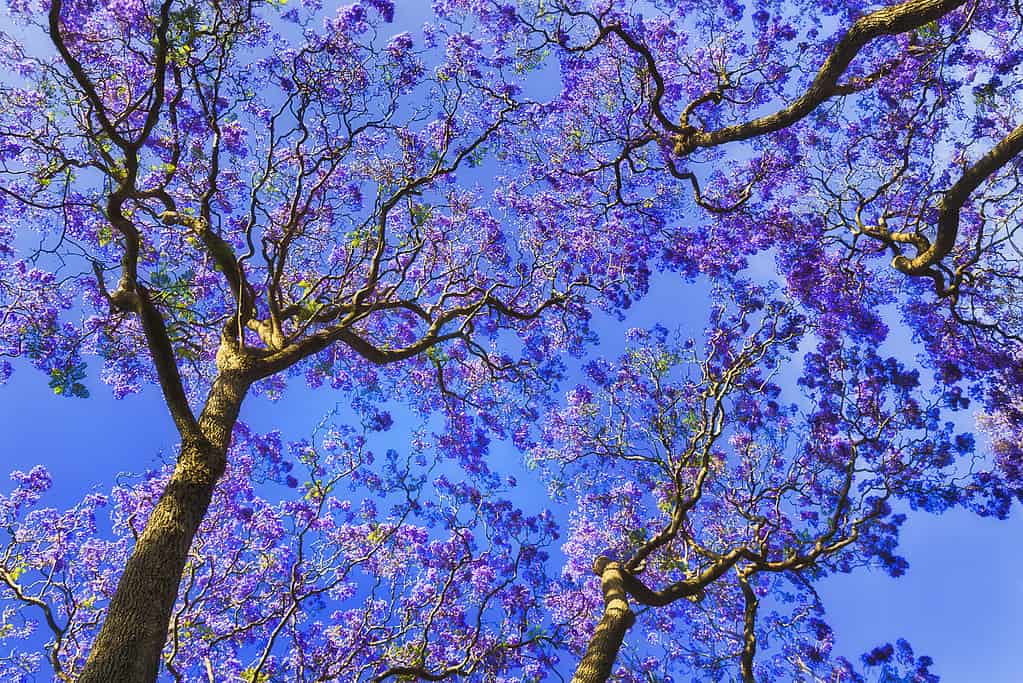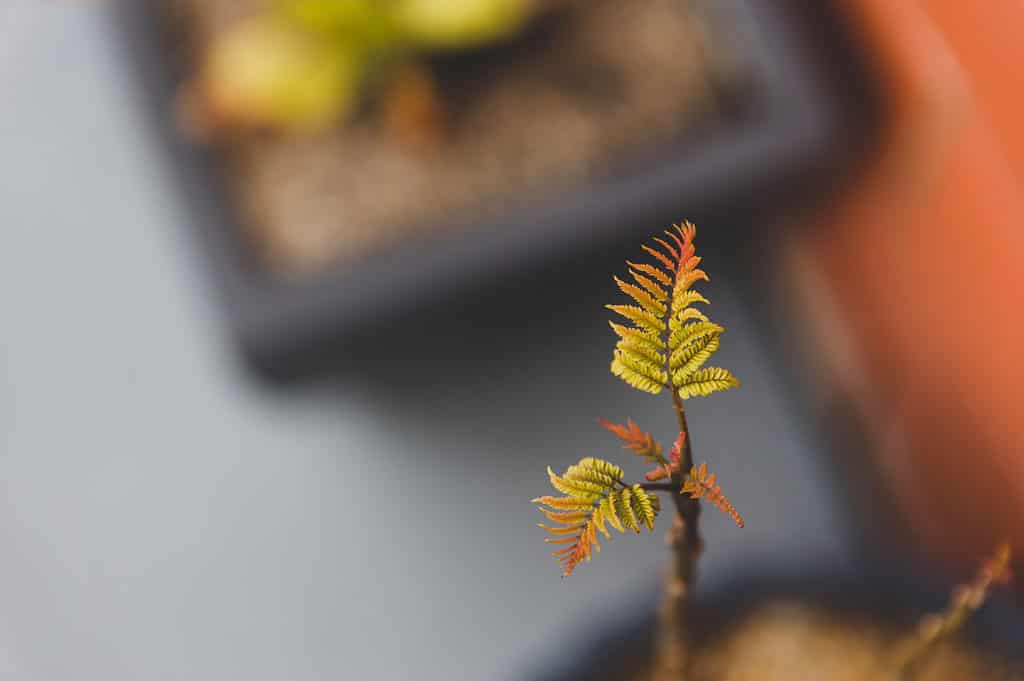The jacaranda tree is grown for its profusion of large, purple flowers and graceful, fountain-like habit. Native to Central and South America and the warmer regions of North America, this tree flourishes in a climate that’s frost free and where sudden, steep drops in temperature are rare. It’s not only deliberately planted in places like California but grows wild on the Iberian Peninsula, in Australia, Africa, and China. The jacarandas that beautify the gardens and parks of Southern California were brought to the area by Kate Sessions (1857-1940), a landscape architect and horticulturalist.

The astounding purple flowers of the jacaranda stand out against a brilliant blue sky.
©zetter/iStock via Getty Images
What It Looks Like
This fast-growing tree grows to between 66 and 98 feet tall, and it tends to be shorter when it is in cultivation. There are 49 species of this purple flowering tree. Most jacaranda trees have bipinnate leaves, which means that there’s a double row of leaflets growing along the central stem. In the jacaranda, there are between 14 and 24 pairs of leaflets, which gives the tree a delicate, ferny look. Other species of jacarandas have pinnate leaves, which means there are single leaflets running along the stem, and a few jacaranda species have simple leaves like oaks or maples. Indeed, the leaves of the jacaranda are so beautiful that the tree is prized for them even if it doesn’t produce a lot of flowers.
The flowers arrive in spring to early summer in panicles that can hold 50 flowers or more. Trumpet shaped, they have five blue, purplish blue or bluish lavender corollas with five lobes. There are cultivars such as White Christmas that produce white flowers. Jacaranda flowers can last as long as two months.
The jacaranda flower produces staminodes, which are sterile stamens that don’t make pollen. In the case of the jacaranda, the staminode is longer than the fertile stamens. A grain of jacaranda pollen has three grooves, or is tricolpate. The sensational flowers ultimately give way to fruit that’s a flat, oddly-shaped capsule full of winged seeds.
Even the Wood is Beautiful
The bark of the jacaranda tree is grayish brown, while its twigs are reddish brown and slender. Besides its beautiful flowers, the jacaranda is used for its timber. The heartwood resembles rosewood, but it’s lighter in color. The wood is pinkish brown to violet brown with a wavy grain and a coarse texture. It’s a bit hard to work with, but people use it to make cabinets, veneers, marquetry, furniture, and cutlery handles.
Where the Name Comes From
The genus name Jacaranda is unusual in that it comes not from the Latin or Greek but from a Tupi-Guarani word that means “fragrant.” Tupi-Guarani is a subfamily of languages spoken by indigenous people of South America.
The Jacaranda genus has two sections, Monolobos and Dilobos. These sections are based on the number of sheaths — one or two — covering the anther on the flower’s stamen. The anther is the body that holds the pollen.
How to Take Care of a Jacaranda Tree
Jacaranda trees can be grown from soft wood cuttings or even from seeds. It’s probably best to buy a sapling from your local nursery.
This gorgeous purple flowering tree grows best in hardiness zones 10 to 11. It thrives in full sun and sandy, well-drained soil with a pH that’s neutral or somewhat acidic. The tree can also stand soil that’s a little clayey or loamy, as long as it drains well. Wet soil can cause root rot and kill the plant. The soil should be kept evenly moist even though the tree can stand a period of drought. It can also stand temperatures as low as 19 degrees Fahrenheit, even though it may not bloom as lavishly later on.
Planting the Tree
It’s best to plant the tree when it’s dormant, which is after the leaves have dropped in the fall or before leaf buds appear in the spring. Since southern California has a mild climate all year, you can plant your jacaranda at any time.
If the tree’s roots are in a burlap ball, take off the burlap and make sure that no roots are circling. If there are circling roots, you should cut them out or straighten them. The hole shouldn’t be any deeper than the root ball, even though you may be tempted to dig deeper. After you set the tree in the hole, make sure that it’s straight. A good idea is to have a helper circle the tree while you hold it to make sure it’s at 90 degrees. If the tree has come with bare roots, it may need staking to keep it straight. You may also want to stake your jacaranda if it’s in a windy place.

You can grow jacaranda trees from seeds.
©faithie/Shutterstock.com
Before covering the roots, add some starter fertilizer to the hole, and cover it with soil. Then plant the tree, water it, tamp it down with your hands to remove air pockets, and water it again. Water the sapling once a week until it is well-established. You may need to water more frequently if the weather’s hot.
The Value of Mulch
Make sure to add mulch around the newly planted sapling. Mulch keeps the soil cool and helps it retain water. Just make sure the mulch doesn’t touch the crown of the tree, where the trunk meets the roots. A well-cared for jacaranda tree can grow 10 feet a year until it reaches its full height and even then it will grow a little bit until the end of its life. Most jacaranda trees live about 50 years, but a very hale and hearty tree can live to be 200.
Starting Your Beautiful Purple Flowering Tree From Seed
If you’re going to grow a tree from seed, pick them from a dry seed pod that’s still hanging on the tree. Soak the seeds for 24 hours then put them in starter medium in a pot. Cover the seed with the medium, and keep it moist. A viable seed will sprout in two weeks to two months. Wait for at least eight months before you place the seedling outside. As with a nursery-bought sapling, the best time to plant is when the seedling is still dormant. When the little tree is “asleep” it experiences less stress when it’s put outdoors.
Watering Your Jacaranda Tree
If you’re not sure if your tree needs watering, poke your finger into the soil round its roots down to 3 or 4 inches. If the soil is dry all the way down, the tree needs water. How much water you give your tree depends on how large it is, what kind of soil it’s in, whether it’s exposed to rain, or whether it’s been planted on a hill.
Generally trees planted in sandy soil need less water than trees planted in other types of soil. Make sure to water the tree around the drip line, where the crown of the tree ends. This is actually where the roots are. Arborists claim a tree in a warm climate should be given 2 to 3 gallons of water per inch of the diameter of the tree’s trunk. So if your sapling has a 4 inch diameter, it needs 8 to 12 gallons of water to be watered deeply.
Fertilizer
The jacaranda should be fed once a year, ideally with a 10-10-10 tree fertilizer. This means the fertilizer is 10 parts nitrogen, 10 parts phosphorous, and 10 parts potassium. Make sure that the tree doesn’t get too much nitrogen because nitrogen prompts the tree to produce more foliage than flowers. It also weakens the tree’s stems and branches. The stems need to be strong to hold the weight of the panicles of gorgeous blooms.
The photo featured at the top of this post is © pulpitis/iStock via Getty Images
Thank you for reading! Have some feedback for us? Contact the AZ Animals editorial team.






